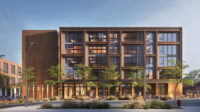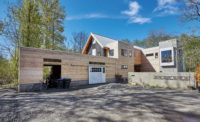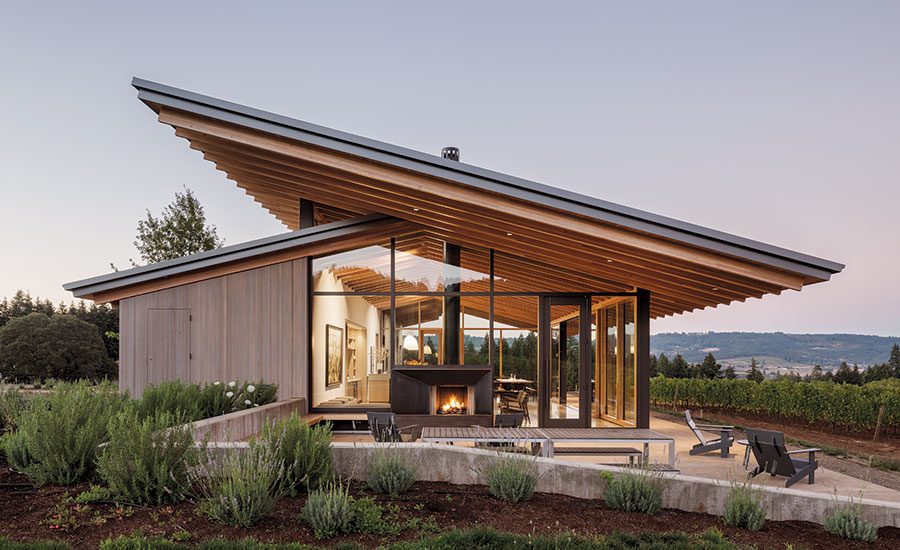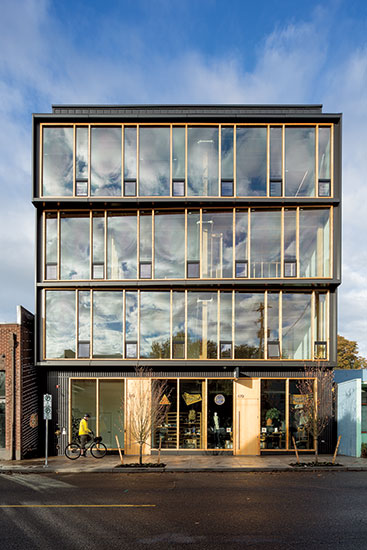Design Vanguard 2017: LEVER Architecture
Portland, Oregon

L’Angolo Estate
A long, low-slung roof and glazed facades that provide views of the surrounding vineyards merge a tasting room in Oregon’s wine country with the surrounding landscape.
Photo © Jeremy Bittermann

Albina Yard
Many of the mass timber technologies employed in the four-story Albina Yard (shown), will be used in another Portland project: Framework. It is slated to become the country’s first wood high-rise.
Photo courtesy LEVER Architecture

Framework
Many of the mass timber technologies employed in the four-story Albina Yard, will be used in another Portland project: Framework (shown). It is slated to become the country’s first wood high-rise.
Photo © Jeremy Bittermann

ArtHouse
The firm’s first stand-alone building was ArtHouse, a six-story, 50-unit apartment complex for students at the Pacific Northwest College of Art. Completed in Portland’s Pearl District in 2013, the accordion folds of its metal skin elevate the building’s otherwise standard exterior cladding material.
Photo © Jeremy Bittermann

Union Way
LEVER transformed a structure—built in the 1920s as a garage, and then home to a nightclub—into a small retail complex in Portland’s West End. A sheltered public passage through the building has walls of regionally grown poplar and a skylit roof supported by the original trusses.
Photo © Jeremy Bittermann





Architects & Firms
LEVER Architecture has received considerable attention since the fall of 2015; that was when its scheme for Framework, a 12-story mixed-use building, won the U.S. Department of Agriculture’s Tall Wood Prize. If all goes as planned, the 145-foot-high building, slated for completion in early 2019 in the firm’s home city of Portland, Oregon, will be the country’s first wood high-rise and the tallest all mass timber building in North America. But for Thomas Robinson, the 48-year-old architect who founded the office in 2009, the significance of the project is broader than the adjectives “first” or “tallest.” Framework speaks to the essence of LEVER’s work, which reconsiders how buildings are made.
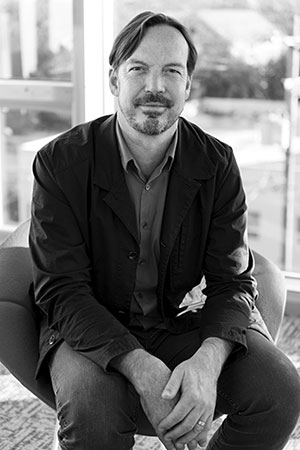
The tower follows on the heels of Albina Yard, a four-story mass timber multi-use building in North Portland where LEVER has its offices. On the front facade, each floor appears subtly skewed and cantilevers slightly beyond the one below. It served as the testing ground for many of the technologies and concepts that will be used at Framework, including the off-site precision fabrication of glulam and cross-laminated timber elements.
Although Robinson is partial to timber, since “people connect with it on an elemental level,” his investigations are not solely focused on that material. The firm’s first stand-alone building, an apartment complex for students at the Pacific Northwest College of Art completed in Portland’s Pearl District in 2013, is enclosed in metal panels that are standard except for their accordion folds. The play of light and shadow on the silvery pleats elevates the cladding type, “making it seem like more than it is” despite a limited budget, says Robinson.
Regardless of the material or the commission, Robinson maintains that a common thread in his projects—and those of the firms he has worked for, including Eshrick Homsey Dodge and Davis, Herzog & de Meuron, and Allied Works—is a desire to enrich the public realm. He points to Union Way in Portland’s West End, a project that transformed a 1920s structure, built as a garage and then home to a nightclub, into a small retail complex. Its most unusual aspect is a covered public passage with walls of regionally grown poplar and a skylit roof supported by the structure’s original timber trusses, giving the shopping arcade a uniquely Pacific Northwest twist.
Although most of LEVER’s projects are in the Portland region, the firm regularly works in Los Angeles and has done projects on the East Coast. A recently completed winery in Newberg, Oregon, is its lone rural project, but Robinson maintains that the same principles apply whether the site is in the city or the country. As with Union Way, he was trying to address a larger context. Its long and low winglike roof, and glazed facades that open onto the vineyards, tie the winery to the landscape.
Robinson hopes to have the chance to tackle a library or school. These are the kinds of projects that, he says, “can demonstrate the value of architecture to the widest audience and bring richer experience to people’s everyday lives.”
LEVER Architecture
FOUNDED: 2009
DESIGN STAFF: 18
PRINCIPALS: Thomas Robinson
EDUCATION: Harvard Graduate School of Design, M.Arch., 2000; University of California, Berkeley, B.Arch., 1991
WORK HISTORY: Allied Works Architecture, 2003–09; Herzog & de Meuron, 2000–03; Esherick Homsey Dodge and Davis, 1991–96
KEY COMPLETED PROJECTS: footwear innovation lab, 2017; Quest for Beauty, Portland Art Museum, 2017; Albina Yard, 2016; L’Angolo Estate Winery, Newberg, Oregon, 2016; TreeHouse, 2015; animation studio renovation, Burbank, California, 2015; global apparel headquarters, Baltimore, 2015; Academy of Motion Picture Arts and Sciences, Beverly Hills, California, 2014; Union Way, 2013; ArtHouse, 2013; creative studio and campus, Glendale, California, 2011 (all in Portland, Oregon, except as noted)
KEY CURRENT PROJECTS: Framework; Grand Avenue housing; environmental-nonprofit offices; Guild’s Lake creative office; the Range, Bend, Oregon; Flex (all in Portland, Oregon, except as noted)


